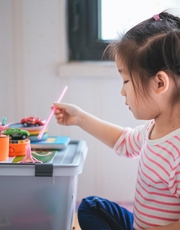Here Are 7 Thoughtful Ways to Teach Your Child About Ableism
Raising children who possess empathy, understanding and respect for all is a powerful goal. Part of this journey involves addressing ableism, a concept that might seem complex but is essential to comprehend to create a more inclusive society.
Ableism refers to discrimination, prejudice or bias against individuals with disabilities. Just as we teach our children about kindness, sharing and fairness, teaching them about ableism is equally important. By equipping our young ones with the tools to understand and challenge ableism, we foster a generation that embraces differences and stands up for those who face challenges.
1. Encourage Open Conversations
We know that raising compassionate and understanding kids is at the top of your parenting list. One fantastic way to achieve that is through open and honest conversations about ableism and disability.
Start by creating an environment where your child feels comfortable asking questions without fearing judgment. Let them know it’s OK to be curious and you’re here to provide them with the information they seek. Showing you’re open to discussing these topics sends a powerful message that these conversations are important and valued.
Remember, discussions about ableism don’t need to be formal sit-downs. Use everyday moments as teaching opportunities. For instance, if you’re watching a TV show or reading a book together and a character encounters a disability, ask your child what they think. This can lead to natural discussions about inclusion and diversity.
2. Share Your Own Learning Journey
Let your child know you’re also learning about ableism and disability alongside them. Share moments when you’ve gained new insights or changed your perspective. This shows humility and reinforces the idea that learning is a lifelong process.
Express to your child that admitting if you’re unsure about something is OK. If your child asks a question you don’t have an answer to, tell them you’ll find out together. This teaches them that seeking knowledge is positive and that it’s fine not to have all the answers right away.
3. Teach Empathy and Respect
Have discussions with your child about how important it is to imagine how other people might feel, especially if they face disability-related challenges. Encourage your child to dig deeper into the topic with questions like “How would I feel in this situation?” This will help foster a sense of compassion.
Help your child understand that they are equipped with an amazing gift — the ability to give time and attention. When they pause to listen to others’ feelings and experiences, it expresses that they care. It sends out empathetic vibes that make the world a better place with each conversation.
Here are a few tips to instill empathy in your child:
- Respect all abilities: Have conversations with your child that help them understand each individual’s own unique abilities and how our differences make us awesome. Whether someone can handle a task on their own or need assistance, it’s essential to respect that person’s way of navigating the world.
- Words have power: Words have power. Explain how some words and phrases can hurt another’s feelings or perpetuate stereotypes about specific conditions or abilities. Give your child the person-first language they need to focus on an individual’s abilities instead of their disabilities.
- Be a friend, not a fixer: Let your child know that, sometimes, people just need a kind ear to listen — not someone to fix their problems. Being there to listen and support is a great way to practice empathy.
4. Introduce Everyday Inclusivity
Remind your child that something as simple as saying hello or smiling at a stranger can improve that person’s day. Encourage them to greet everyone they meet, whether that person has a disability or not. Work together with your child to help them learn the value of helping others, whether that’s holding the door open, picking up something that was dropped or offering assistance. Acts of kindness can help your child express that they care.
5. Invite Everyone to Play
Encourage your child to be a leader in inclusivity during playtime. When organizing games or activities, make sure everyone is invited to join. This way, they’re not just having fun, but also spreading a message of acceptance.
If they’re having a conversation with someone who communicates differently, like using sign language or assistive technology, remind your child to be patient and attentive. Encourage them to ask questions if they’re curious about someone’s abilities, always respectfully and sensitively.
Everyday inclusivity is like planting little seeds of kindness that grow into a more inclusive world. By teaching your child these simple actions, you’re helping them create a positive ripple effect far beyond their immediate circle.
6. Lead by Example
Your child is watching your interactions closely. Treating everyone with kindness, respect and empathy demonstrates the behavior you want them to adopt. Whether you’re talking to a neighbor, a coworker or a stranger, be that shining example of inclusivity.
Surround yourself with a diverse group of friends and acquaintances. Your child will see that you value people from all walks of life. This exposure helps them realize the richness of human diversity.
Other ways you can show the way are:
- Use inclusive language: Make it a habit to use inclusive language at home. If you’re discussing someone with a disability, emphasize that person’s abilities and achievements alongside their challenges. This showcases that you focus on the person as a whole.
- Advocate for accessibility: If you encounter situations that lack accessibility for people with disabilities, speak up. Explain to your child why accessibility matters and show them that advocating for equal rights is essential.
7. Keep Learning Together
Make a habit of discovering books, movies, TV shows and documentaries that feature characters with disabilities. These stories provide wonderful opportunities to discuss ableism, empathy and inclusion.
Remember, this journey isn’t about reaching a destination — it’s about the adventure of continuous growth and learning. By embracing this attitude of ongoing exploration, you’re teaching your child that there’s always more to discover, understand and appreciate about the world around them.
About the Author
 Ava Roman (she/her) is the Managing Editor of Revivalist, a women’s lifestyle magazine that empowers women to live their most authentic life. When Ava is not writing you’ll find her in a yoga class, advocating for her children or whipping up something delicious in the kitchen!
Ava Roman (she/her) is the Managing Editor of Revivalist, a women’s lifestyle magazine that empowers women to live their most authentic life. When Ava is not writing you’ll find her in a yoga class, advocating for her children or whipping up something delicious in the kitchen!





